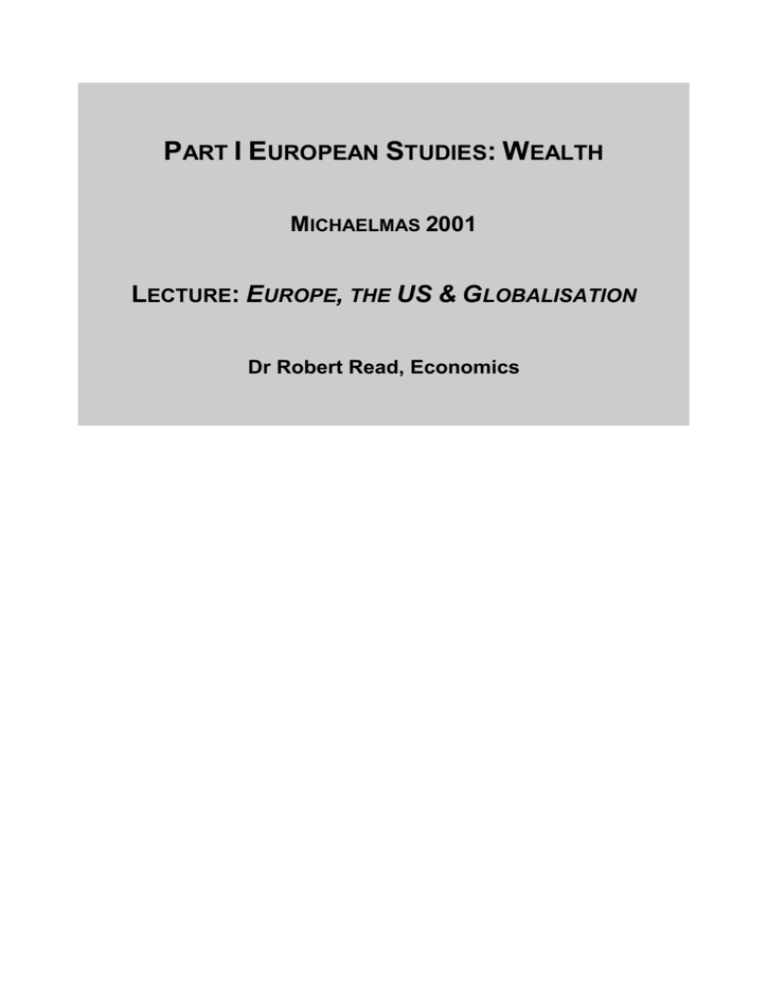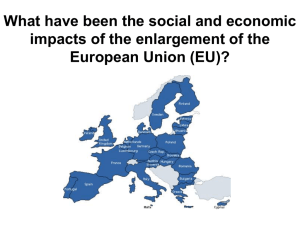ECON 318
advertisement

PART I EUROPEAN STUDIES: WEALTH MICHAELMAS 2001 LECTURE: EUROPE, THE US & GLOBALISATION Dr Robert Read, Economics European Studies: Globalisation EUROPE, THE US & GLOBALISATION I. WHAT IS GLOBALISATION? II. THE RISE OF US BUSINESS III. THE US CHALLENGE IV. THE GLOBALISATION OF BUSINESS V. THE GLOBAL CHALLENGE European Studies: Globalisation THE WORLD’S LEADING ECONOMIES Table 1: GDP, Population & Income 1999 GDP ($bn) Pop (m)Income ($) High Income 22,921 891 25,730 Middle Income – high 2,811 573 4,900 Middle Income – low 2,513 2,667 1,200 988 2,417 410 Low Income Table 2: World’s Top 10 Economies 1960, 1999 1960 1. 1999 United States 506.7 United States 8,351 EU-15 331.0 EU-15 8,213 2. West Germany 72.1 Japan 4,079 3. UK 71.4 Germany 2,079 4. France 60.1 France 1,427 5. Japan 43.1 UK 1,338 6. Italy 37.2 Italy 1,136 7. India 29.6 China 980 8. Brazil 24.1 Brazil 743 9. Sweden 14.0 Canada 591 10. Mexico 12.0 Spain 552 European Studies: Globalisation WHAT IS GLOBALISATION? The increasing level of international integration and interdependence in the world economy. It comprises several separate but inter-linked components. Increasing international trade liberalisation and the emergence of regional economic blocs (EU, NAFTA). The liberalisation of international capital movements and exchange rates, increasing capital mobility. The emergence of multinational enterprises (MNEs) as key agents of international economic co-ordination. The rise of the dynamic newly industrialising countries (NICs) based upon export-led growth (eg Korea). The intensification of International Competition, between countries and between firms, driven by technological advances and the internationalisation of production based upon the division of labour. European Studies: Globalisation GLOBALISATION PRE-1914 Commentators argue that globalisation today does not yet match that of the world economy before 1914. Supporting Arguments Greater international trade relative to total economic activity (trade/GDP). Greater FDI relative to total investment. Greater economic (relative) interdependence. Counter Arguments Substantially greater volume of international trade and economic activity now but lower (trade/GDP) – more countries have larger home markets. Substantially greater volume of FDI now while total investment has also risen. The nature of FDI has changed. A greater absolute degree of economic inter- dependence (much higher incomes). European Studies: Globalisation THE GROWTH OF SCIENTIFIC MANAGEMENT Communications Significant improvements in communications and economic co-ordination – trains, telegraph, telephone, shipping - in the mid- to late 19th Century. Separation of Firm Ownership & Control To grow, firms needed to be larger – achieved by issuing shares. Family owners could no longer control how firms were run; decisions were answerable to share holders. Specialisation & Professionalisation Larger firms needed specialists to process and coordinate increasing volumes of information. This led to the emergence of the management professions – employees with specific managerial skills (accountants). Management Structures The emergence from 1919 (Du Pont and General Motors) of scientific management structures to improve managerial co-ordination and decision-making. M-form. European Studies: Globalisation THE POST-WAR AMERICAN CHALLENGE Servan-Schreiber described the massive inflow of US foreign direct investment (FDI) into Europe in the two decades after the War as Le Défi Americain. The flow was one-way, explained by: The search for new markets. Strength of the $. New and better products. More efficient management systems. Large US firms up against inefficient European firms in fragmented markets. European Studies: Globalisation THE EUROPEAN RESPONSE By the mid-1960s, the wave of US FDI in Europe started to slow-down. Gradual growth of European FDI, both in the US but also elsewhere in Europe – intra-EU – and some in what became the NICs. The UK again emerged as a major source of FDI. Much of the European FDI was smaller scale than that of the US. Explanations for the growth of European FDI: Economic growth (effects of EU integration) and greater wealth – more investment. Some relaxation of foreign exchange controls. Increasing competitiveness of European firms – improved management techniques, larger size, less fragmented markets (EU). Significant reduction of global trade barriers in manufactured goods through the GATT Rounds Kennedy (1963-67) and Tokyo (1973-79) European Studies: Globalisation THE CHANGING NATURE OF TRADE & FDI Trade and FDI were originally regarded as substitutes: that is that FDI was a response to protectionism. This phenomenon was particularly noticeable in the 1920s and 1930s with cross investment by the US and Europe in an environment of increasing protectionism. Foreign subsidiaries can be viewed as clones of the parent company – replicating structures and activities. Since the 1960s, international trade has grown at double the rate of economic growth (5% compared with 2.5%) and FDI has grown at twice this rate (around 10%). Trade liberalisation has led to increasing (complementary) FDI. Switch away from ‘clone’ foreign operations to networks of subsidiaries undertaking different activities – based upon the International Division of Labour. This is the spatial location of economic activity according to different labour costs – labour-intensive activities in the NICs and LDCs and capital- and technology-intensive activities in the industrialised countries. European Studies: Globalisation TRADE & FDI IN THE GLOBAL ECONOMY The great proportion of global trade and FDI is undertaken between the industrialised economy. Much of this trade is in similar products - Intra-Industry Trade (branded manufactures) while trade with developing countries is Inter-Industry (manufactures and services traded for commodities) The bulk of global FDI is also between industrialised economies, especially between the US and EU. Table 3: Inward & Outward Stock of Global FDI, 1999 Inward (%) Outward (%) World 6,314 100.0 5,976 100.0 Developed Countries 4,210 66.8 5,249 87.8 US 1,239 19.6 1,245 20.8 54 7.9 282 4.7 EU 2,376 37.6 3,111 52.1 UK 483 7.6 902 15.1 Germany 461 7.3 442 7.4 France 266 4.2 497 8.3 Japan European Studies: Globalisation GLOBALISATION & TECHNOLOGY Firms, and particularly MNEs, from the industrialised countries are the principal creators of innovations and new technologies. They are at the ‘leading edge’ – other countries can grow fast without innovating. Technological progress made possible by: High levels of investment in R&D. Availability of skilled researchers (human capital). Pressures of competition, the need for competitive advantages over other firms. In the last two decades, globalisation has created new challenges: The rate of technological change is accelerating – greater risks, costs and (potentially) profits. More firms collaborate in R&D – EU SEM and Competition Law. Increased R&D and innovation being undertaken in the NICs – Korea, Brazil, China etc. New challenge to the US and EU. European Studies: Globalisation GLOBALISATION: THE KEY CHALLENGES Growing global interdependence between countries is leading to the declining role of the nation state, notably in the EU but also elsewhere. Increasing role of regional trade blocs, EU, NAFTA, FTAA. Greater interdependence means greater possibility of contagion – economic and financial instability affecting many countries rapidly. Mutual benefits of growth. Growing wealth gap between countries and within countries – increasing international inequality, caused primarily by differences in education and opportunity. The growing need for supra-national institutions to enforce the ‘rules’ to stop cheating and enable all to benefit – eg the WTO.








